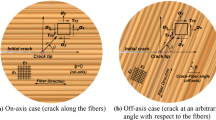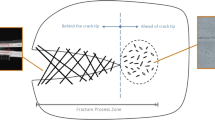Abstract
A mixed-mode fracture specimen was designed in this paper. This geometry is a judicious compromise between a modified Double Cantilever Beam specimen and Compact Tension Shear specimens. The main objective is to propose a specimen which traduces a stable crack growth during creep loading taking into account viscoelastic behaviour under mixed-mode loadings. The numerical design is based on the instantaneous response traduced by a crack growth stability zone. This zone is characterized by a decrease of the instantaneous energy release rate versus the crack length. In order to obtain a mixed-mode separation, the paper deals with the use of the M-integral approach implemented in finite element software, according to energetic fracture criterions. In these considerations, a numerical geometric optimization is operated for different mixed-mode ratios. Finally, a common specimen which provides to obtain fracture parameters, viscoelastic properties and creep crack growth process for different mixed-mode configurations is proposed.
Similar content being viewed by others
References
Ando K, Ohta M (1999) Variability of fracture toughness by the crack tip position in an annual ring of coniferous wood. J Wood Sci 45: 275–283. doi:10.1007/BF00833491
Attigui M, Petit C (1999) Mixed-mode separation in dynamic fracture mechanics: new path independent integrals. Int J Fract 84: 19–36. doi:10.1023/A:1007358701493
Banks-Sills L, Arcan M, Bortman Y (1984) A mixed-mode fracture specimen for mode II dominant deformation. Eng Fract Mech 20: 145–157
Banks-Sills L, Hershkovitz I, Wawrzynek PA, Eliasi R, Ingraffea AR (2005) Methods for calculating stress intensity factors in anisotropic materials: part I—z = 0 is a symmetric plane. Eng Fract Mech 72: 2328–2358
Banks-Sills L, Wawrzynek PA, Carter B, Ingraffea AR, Hershkovitz I (2007) Methods for calculating stress intensity factors in anisotropic materials: part II—arbitrary geometry. Eng Fract Mech 74: 1293–1307
Bao G, Ho S, Suo Z, Fan B (1992) The role of material orthotropy in fracture specimens for composites. Int J Solids Struct 29: 1105–1116
Chen FMK, Shield RT (1977) Conservation laws in elasticity of J-integral type. J Appl Mech Phys 28: 1–22
Chow CL, Woo CW (1979) Orthotropic and mixed mode fracture in wood. In: Proceedings of the 1st international conference of wood fracture. Vancouver, pp 39–52
Cramer SM, Pugel AD (1987) Compact shear specimen for wood mode II fracture investigations. Int J Fract 35: 163. doi:10.1007/BF00015586
De Moura MFSF, Silva MAL, de Morais AB, Morais JJL (2006) Equivalent crack based mode II fracture characterization of wood. Eng Fract Mech 73: 978–993. doi:10.1016/j.engfracmech.2007.03.005
Destuynder P, Djaoua M, Lescure S (1983) Quelques remarques sur la mécanique de la rupture élastique. J Mec Theor Appl 2: 113–135
Dubois F, Chazal C, Petit C (1999) A finite element analysis of creep-crack growth in viscoelastic media. Mech Time Dependent Mat 2: 269–286. doi:10.1023/A:1009831400270
Dubois F, Chazal C, Petit C (2002) Viscoelastic crack growth process in wood timbers: an approach by the finite element method for mode I fracture. Int J Fract 113: 367–388. doi:10.1023/A:1014203405764
Dubois F, Petit C (2005) Modelling of the crack growth initiation in viscoelastic media by the Gθv-integral. Eng Fract Mech 72: 2821–2836
Guittar D (1987) Mécanique du matériau bois et composites, CEPADUES-EDITIONS. Collection NABLA
Guo YJ, Weitsman YJ (2004) A modified specimen for evaluating the mixed mode fracture toughness of adhesives. Int J Fract 107: 1573–2673. doi:10.1023/A:1007618718262
Ma S, Zhang XB, Recho N, Li J (2006) The mixed-mode investigation of the fatigue crack in CTS metallic specimen. Int J Fatigue 28: 1780–1790. doi:10.1016/j.ijfatigue.2006.01.005
Mackerle J (2005) Finite element analysis in wood research: a bibliography. Wood Sci Technol 39: 579–600. doi:10.1007/s00226-005-0026-9
Mindess S, Bentur A (1986) Crack propagation in notched wood specimens with different grain orientations. Wood Sci Technol 20: 145–155. doi:10.1007/BF00351026
Morel S (2007) R-curve and size effect in quasibrittle fracture: case of notched structures. Int J Fract 44: 4272–4290
Moura MFSF, Silva MAL, de Morais AB, Morais JJL (2007) Equivalent crack based mode II fracture characterization of wood. Eng Fract Mech 73: 978–993. doi:10.1016/j.engfracmech.2007.03.005
Moutou Pitti R, Dubois F, Petit C, Sauvat N (2006) Fracture of wood under mixed mode loading: numerical approach by the Mθ v-integral. In: 9th word conference of timber engineering Portland OR, USA, August 6–10
Moutou Pitti R, Dubois F, Pop O, Sauvat N, Petit C (2007a) Mv-integral for the crack growth in a viscoelastic media. C R Mécanique 335: 727–731. doi:10.1016/j.crme.2007.07.004
Moutou Pitti R, Dubois F, Petit C, Sauvat N (2007b) Mixed mode fracture separation in viscoelastic orthotropic media: numerical and analytical approach by the Mθv-integral. Int J Fract 145: 181–193. doi:10.1007/s10704-007-9111-4
Moutou Pitti R, Dubois F, Petit C et al (2008) A new M integral parameter for mixed mode crack growth in orthotropic viscoelastic material. Eng Fract Mech 75: 4450–4465. doi:10.1016/j.engfracmech.2008.04.021
Moutou Pitti R, Dubois F, Pop O, Absi J (2009) A finite element analysis for mixed mode crack growth in a viscoelastic and orthotropic medium. Int J Solids Struct 46: 3548–3555. doi:10.1016/j.ijsolstr.2009.05.020
Noether E (1971) Invariant variations problems. Trans Theor Stat Phys 1: 183–207
Oliveira JMQ, De Moura MFSF, Silva MAL, Morais JJL (2007) Numerical analysis of the MMB test for mixed-mode I/II wood fracture. Compos Sci Technol 67: 1764–1771. doi:10.1016/j.compscitech.2006.11.007
Rice JR (1968) A path independent integral and the approximate analysis of strain conservation by notches and cracks. J Appl Mech 35: 379–385
Richard HA (1981) A new compact shear specien. Int J Fract 17: R105–R107. doi:10.1007/BF00033347
Richard HA, Benitz K (1983) A loading device for the creation of mixed mode in fracture mechanics. Int J Fract 22: R55–R58. doi:10.1007/BF00942726
Sedighi-Gilani M, Job L, Navi P (2006) Three-dimensional modelling of wood fracture in mode I, perpendicular to the grain direction, at fibre level. Wood Mater Sci Eng 1: 52–58. doi:10.1080/17480270600881835
Sih GC (1974) Strain energy density factor applied to mixed mode crack problems. Int J Fract 10: 305–321. doi:10.1007/BF00035493
Silva MAL, Moura MFSF, Morais JJL (2006) Numerical analysis of the ENF test for mode II fracture. Compos Part A Appl Sci Manuf 37: 1334–1344. doi:10.1016/j.compositesa.2005.08.014
Tenchev RT, Falzon BG (2007) A correction to the analytical solution of the mixed-mode bending (MMB) problem. Compos Sci Technol 67: 662–668
Valentin G, Morlier P (1982) A criterion of crack propagation in timber. Mat Constructions 88: 291–298
Valentin G, Caumes P (1989) Crack propagation in mixed mode in wood: a new specimen. Wood Sci Technol 23: 43–53. doi:10.1007/BF00350606
Xu Y, Yuan H (2009) Computational modelling of mixed-mode fatigue crack growth using extended finite element methods. Int J Fract 159: 151–165. doi:10.1007/s10704-009-9391-y
Yoshihara H, Ohta M (2000) Measurements of mode II fracture toughness of wood by end-notched flexure test. J Wood Sci 46: 273–278
Yoshihara H (2008) Theoretical analysis of 4-ENF test for mode II fracturing in wood by finite element method. Eng Fract Mech 75: 290–296. doi:10.1016/j.engfracmech.2007.03.043
Zhang XB, Ma S, Recho N, Li J (2006) Bifurcation and propagation of a mixed-mode crack in a ductile material. Eng Fract Mech 73: 1925–1939. doi:10.1016/j.engfracmech.2005.12.013
Author information
Authors and Affiliations
Corresponding author
Rights and permissions
About this article
Cite this article
Moutou Pitti, R., Dubois, F. & Pop, O. A proposed mixed-mode fracture specimen for wood under creep loadings. Int J Fract 167, 195–209 (2011). https://doi.org/10.1007/s10704-010-9544-z
Received:
Accepted:
Published:
Issue Date:
DOI: https://doi.org/10.1007/s10704-010-9544-z




